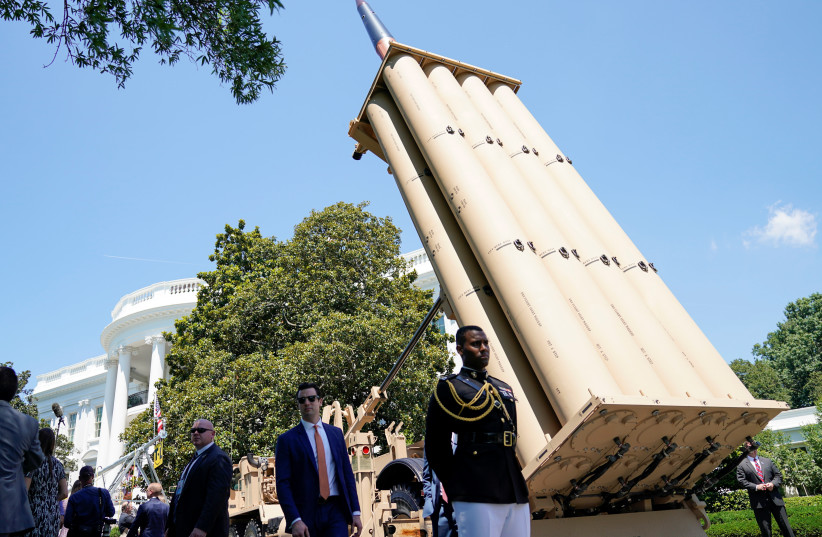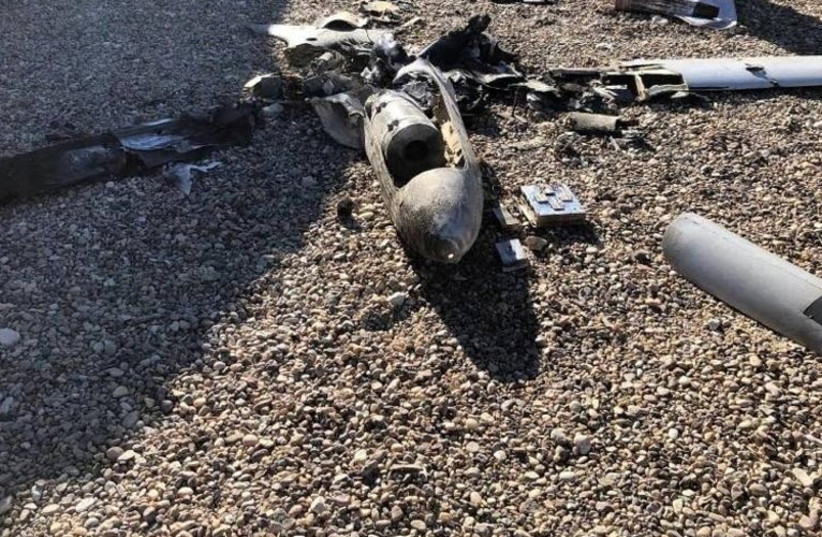The Terminal High Altitude Area Defense (THAAD) system was used for the first time in a military operation during a drone and missile attack on the UAE last week.
By SETH J. FRANTZMAN
Published: JANUARY 22, 2022 23:23

A Lockheed Martin Terminal High Altitude Area Defense (THAAD) missile interceptor is seen during the third annual “Made in America Product Showcase” on the South Lawn of the White House in Washington, US, July 15, 2019.
(photo credit: REUTERS/KEVIN LAMARQUE)
The reported use of the Terminal High Altitude Area Defense, or THAAD, system to defend the UAE during a drone and missile attack last week has brought a spotlight on the system as well as the need for air defenses in the region. The use of the system was first reported by Defense News over the weekend. UAE Ambassador to the US Yousef al-Otaiba had earlier revealed that there were interceptions during the attack on the UAE but he did not mention the type of system used.
Defense News reported that THAAD, “a multibillion-dollar missile defense system owned by the United Arab Emirates and developed by the US military[,] intercepted a ballistic missile on Monday during a deadly attack by Houthi militants in Abu Dhabi, marking the system’s first known use in a military operation.” The Drive noted that “it brought down a ballistic missile during its first recorded successful operational use, in the hands of the United Arab Emirates. The ballistic missile that was targeted was fired by Houthi militants during last Monday’s attack on ‘sensitive Emirati sites and facilities.’”
According to the Defense News report, the system was used to stop a threat to oil facilities. The attack took place on January 17 and a key detail that was unknown at the time was why there weren’t more interceptions of the incoming drone and missile threats. Several days after the attack Al Otaiba was speaking at an event at the Jewish Institute for National Security of America (JINSA) and said the attacks on the UAE involved “a combination of cruise missiles, ballistic missiles and drones, targeted civilian sites in the UAE.” He said that several of the incoming threats were intercepted.
The details are based on anonymous sources but they haven’t been denied. Defense News further says that US Central Command had confirmed that there was an inbound threat and that US service members at Al-Dhafra base, several kilometers from where the targeted oil facilities are located, had to shelter for thirty minutes. “Airmen were directed to keep their protective gear close for 24 hours afterwards,” the report said. “Everything was professional and disciplined. The ‘all clear’ was called at 9:27 p.m. local time,” said Capt. Bill Urban, a spokesman for the command. “There was no mission impact.”
It’s not clear if that event is linked directly to the attack on the UAE because it appears that the incident occurred the night before. Either way, what is important is we now know that air defenses were used. That means some of the threats were detected.

Why this matters is because air defense throughout the region is increasingly being tested by Iranian and Iranian-backed threats. Iran develops a plethora of ballistic missiles, cruise missiles and drones and it continues to improve them. These, along with their precision-guided munition features, are a major threat. They are a threat not only to the UAE and Saudi Arabia but also a threat to Israel, US forces and others. Since 2019 these threats have radically increased. Iran has flown drones into Israeli airspace twice, once in 2018 and again in 2021. Iran has helped the Houthis target Saudi Arabia and even moved sophisticated drones into Yemen. It also attacked a ship in July 2021, killing two people. It also attacked Saudi Arabia’s Abqaiq in 2019 using drones and cruise missiles. It attacked US forces at Asad base in Iraq in January 2020 with ballistic missiles. The attack on the UAE was the latest complex attack. It involved a variety of missiles and drones.
All this adds up. It also means that countries in the region such as Israel and the UAE need the right mix of radar and air defenses to stop these attacks. There are a variety of systems made by Israel, the US and other countries that can stop drone and missile threats. Israel’s Iron Dome is one such system. David’s Sling and Arrow, both of which are made by Israeli defense companies and supported by the US in their development, are also key defenses meant to stop various threats. The Patriot system and THAAD, as well as the lower range C-RAM, are American systems. Together these make up the variety of systems in the region that can defend against threats. European countries also make air defense systems. Taken together the story of the use of interceptors to stop some of the threats to the UAE is good news because it shows some threats were detected and neutralized. However, it is also problematic news because the Houthi threat was known and the escalation had been threatened for days before the attack. That a US base and the UAE were still threatened and some projectiles got through means the region must learn the lesson from the attack.
Content retrieved from: https://www.jpost.com/international/article-694254.